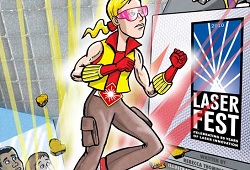
On May 16, 1960, American physicist Theodore Maiman shined a high-power flash lamp on a ruby rod containing a silver-coated surface, producing the world’s first laser beam. Maiman submitted an article on his experiment to Physical Review Letters but the periodical declined to print it – little was known about lasers at the time, including their potential usage.
Maiman next approached Nature, which agreed to publish the article in their August 6 edition. A public announcement was made, which caused a frenzied discussion about potential death rays. It wasn’t long before more practical applications became evident, however, and in the twenty-first century lasers are used for everything from DVD players to light shows, fiber optic communication systems to surgeries.
In celebration of the fiftieth anniversary of Theodore Maiman’s achievement, the American Physical Society debuted a new comic book superhero named Spectra whose powers were similar to those of a laser. Lucinda Hene is a student at Nikola Tesla Junior High School who suddenly discovers that she can play a CD simply by holding it in her hands, move at rapid speeds, reflect off mirrors, and pass through such transparent surfaces as a fish bowl and her bedroom windows. Fortunately, her physics class is currently studying lasers, giving her sufficient knowledge on her new abilities.
Spectra – the superhero moniker that Lucinda Hene chooses for herself – is the brainchild of physicist Rebecca Thompson, who wanted to teach physics in a more informal and inventive way than a classroom. The American Physical Society offered her the chance to do so, resulting in a Nikola Tesla and the Electric Fair one-shot comic book in 2008. Two years later Spectra was born, and the character’s popularity exceeded expectations, eventually leading to a series of eleven comic books and multiple appearances at San Diego Comic-Con.
“The idea is to get people interested in the story through (Lucinda’s) life and her friends, and really hook them with the story, and then teach them the physics underneath that,” Rebecca Thompson explained to The Tech, a college newspaper at the Massachusetts Institute of Technology. “So all of the characters, everything that you see, is actual physics concepts taught through a story about her life.”
The first issue of Spectra introduces the basic skills of Lucinda Hene as she experiments with her abilities and combats an evil psychist named Miss Alignment who is intent on shutting down all working lasers in existence. Issue two includes an appearance by the ghost of Irnee D’Haenens, who assisted Theodore Maiman in May 1960. D’Haenens takes Lucinda Hene on a journey into the past and the history of the laser, demonstrating that no singular individual can truly take credit for its invention in the process.
“No one person can do everything,” he tells Lucinda. “You have to work together with colleagues and friends.”
The new substitute physics teacher in issue three, meanwhile, is a retired Army veteran turned engineer named General Leslie J. Relativity (i.e., General Relativity), while the mechanic who repairs the van belonging to Lucinda’s mom – causing it to appear in two places at once, a fictionalized example of quantum superposition – refers to herself as the Quantum Mechanic. Physicist James Maxwell advocated using an imaginary demon in 1867 to stimulate “thought experiments,” and that demon is brought to life in issue four of Spectra, courtesy of new student Tiffany Maxwell.
The names of Lucinda Hene and her friends at Nikola Tesla Junior High School also have ties to physics and lasers. Since the initial laser of Theodore Maimain used a synthetic ruby, for instance, Lucinda’s best friend is named Ruby. The names of Lucinda and Ruby’s male counterparts – Gordy and Kas – are shortened versions of physicists Gordon Gould and Alfred Kastler. As for the star of the comic book, the most popular type of laser is the Helium Neon, or HeNe for short.
“The fact that our superhero is a girl was no accident,” Rebecca Thompson told The Tech while attending San Diego Comic-Con in 2014. “We really wanted to engage girls in physics, and girls in science in general. One thing we realize, as we see all these little girls walking through here, they’re like, ‘Wait, is this a superhero for me?’ ‘Cause so many of the superheroes are men or boys, and this is for them, their age level. And really, going forward, we’re hoping to find new and interesting ways to get them into the hands of as many people as possible, and get as many people as possible interested in this.”
With eleven issues of a comic book intentionally designed to teach physics and seven visits to San Diego Comic-Con, one can’t help but consider Rebecca Thompson’s goal to be a resounding success, something that even Thompson herself had to admit.
“We had one dad who was a physicist, brought the comics home from a conference, threw them down, and three days later his kid is coherently explaining lasers to him,” she told the Society of Physics Students. Then came the ultimate proof that the character was resonating with its audience. “A mom called us and said, ‘I didn’t even ask her to do this, but my daughter dressed up as Spectra for Halloween,’” Thompson told The Tech. “When all of this started, I said, ‘The day someone dresses up as Spectra for Halloween, I’m just gonna retire,’ thinking it would never happen. So the day that happened was really special.”
The same could be said of Spectra – the Original Laser Superhero.
Anthony Letizia

